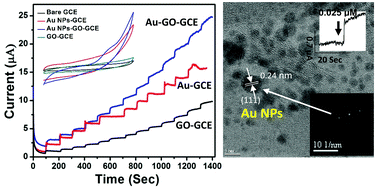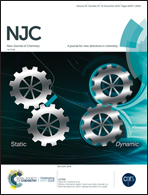Synergic effect of plasmonic gold nanoparticles and graphene oxide on the performance of glucose sensing†
Abstract
In this study hybrid nanostructures of Au–graphene oxide (Au–GO) were synthesized via a two-step process and used to modify the glassy carbon electrode (GCE) for electrochemical measurements of glucose. The modified electrode exhibits a fast response less than 4 s, a low detection limit of 0.025 μM and a high signal-to-noise ratio (S/N) of 3.5. The fabricated sensor shows a linear response in a large concentration range from 0.0025 mM to 15 mM with a reproducible sensitivity of 84.53 μA cm−2 mM−1, which is much higher than that of the individual Au, GO and previously reported GO/rGO based sensors. In addition, the biosensor shows excellent results for human serum which agree well with those obtained using a laboratory glucometer. Moreover, the glucose amount in selective commercially available food samples and fresh juices was also successfully measured. The biosensor exhibits excellent selectivity, thermal stability and reproducibility. The enhanced and efficient sensitivity of the developed Au–GO based biosensor may be due to the synergic effects of the plasmonic Au-nanoparticles and GO. The performance of the biosensor suggests that the reported Au–GO hybrid nanostructures can provide a novel platform for developing non-enzymatic biosensors for biomedical and industrial applications.



 Please wait while we load your content...
Please wait while we load your content...